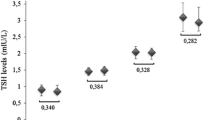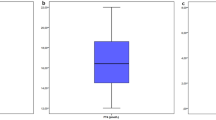Abstract
Background and aims: It is recognized that overt thyroid dysfunction is associated with weight changes, but the influence of a minor alteration of thyroid function remains unclear. This study aimed to further investigate the relationship between obesity and thyroid function and to examine the possible role of insulin resistance on the hypothalamic-pituitary-thyroid axis. Methods and results: Serum TSH and free T4 (FT4) levels, anthropometric and metabolic parameters were evaluated in 581 obese patients. In all patients TSH values progressively increased according to the severity of obesity and were positively correlated with body mass index (p=0.001, r=0.13) and waist circumference (p=0.02, r=0.11). Patients with insulin resistance showed higher TSH (1.8±1.0 vs 1.6±0.9 μUI/l; p=0.03) and lower FT4 levels (13.8±2.3 vs 15.0±2.2 pmol/l; p<0.001), as compared with patients with normal insulin sensitivity. Moreover, TSH was positively correlated with fasting insulin (p<0.001, r=0.152) and homeostasis model assessment of insulin resistance (HOMA-IR; p<0.001, r=0.148), and negatively correlated with Quantitative Insulin Sensitivity Check Index (QUICKI; p<0.001, r=−0.148); FT4 was negatively associated with fasting insulin (p<0.001, r=−0.287) and HOMA-IR (p<0.001, r=−0.295), and positively associated with QUICKI (p<0.001, r=0.295). Conclusions: A relationship between thyroid function and overweight/obesity condition seems to exist, mainly influenced by insulin resistance. Whether variations in TSH and/or thyroid hormones, within a normal range, can influence body weight or whether obesity per se can alter thyroid function cannot be stated so far. Further studies are needed to assess the link between thyroid function and body weight, by considering not only changes in thyroid hormones, but also body fat distribution, obesity duration and low-grade inflammation.
Similar content being viewed by others
References
Douyon L, Schteingart DE. Effect of obesity and starvation on thyroid hormone, growth hormone, and cortisol secretion. Endocrinol Metab Clin North Am 2002, 31: 173–89.
Michalaki MA, Vagenakis AG, Leonardou AS, et al. Thyroid function in humans with morbid obesity. Thyroid 2006, 16: 73–8.
Knudsen N, Laurberg P, Rasmussen LB, et al. Small differences in thyroid function may be important for body mass index and the occurrence of obesity in the population. J Clin Endocrinol Metab 2005, 90: 4019–24.
Manji N, Boelaert K, Sheppard MC, Holder RL, Gough SC, Franklyn J. Lack of association between serum TSH or free T4 and body mass index in euthyroid subjects. Clin Endocrinol (Oxf) 2006, 64: 125–8.
Iacobellis G, Ribaudo MC, Zappaterreno A, Iannucci CV, Leonetti F. Relationship of thyroid function with body mass index, leptin, insulin sensitivity and adiponectin in euthyroid obese women. Clin Endocrinol (Oxf) 2005, 62: 487–91.
Roos A, Bakker SJ, Links TP, Gans RO, Wolffenbuttel BH. Thyroid function is associated with components of the metabolic syndrome in euthyroid subjects. J Clin Endocrinol Metab 2007, 92: 491–6.
De Pergola G, Ciampolillo A, Paolotti S, Trerotoli P, Giorgino R. Free triiodothyronine and thyroid stimulating hormone are directly associated with waist circumference, independently of insulin resistance, metabolic parameters and blood pressure in overweight and obese women. Clin Endocrinol (Oxf) 2007, 67: 265–9.
Bastemir M, Akin F, Alkis E, Kaptanoglu B. Obesity is associated with increased serum TSH level, independent of thyroid function. Swiss Med Wkly 2007, 137: 431–4.
Bakker SJ, Ter Maaten JC, Popp-Snijders C, Slaets JP, Heine RJ, Gans RO. The relationship between thyrotropin and low density lipoprotein cholesterol is modified by insulin sensitivity in healthy euthyroid subjects. J Clin Endocrinol Metab 2001, 86: 1206–11.
Dimitriadis G, Mitrou P, Lambadiari V, et al. Glucose and lipid fluxes in the adipose tissue after meal ingestion in hyperthyroidism. J Clin Endocrinol Metab 2006, 91: 1112–8.
Dimitriadis G, Mitrou P, Lambadiari V, et al. Insulin action in adipose tissue and muscle in hypothyroidism. J Clin Endocrinol Metab 2006, 91: 4930–7.
World Health Organization. Obesity: preventing and managing the global epidemic. Report of a WHO Consultation. WHO Technical Report Series 894. Geneva: World Health Organization 2000, 1–253.
The Expert Panel on Detection, Evaluation, and Treatment of High Blood Cholesterol in Adults. Executive Summary of the Third Report of the National Cholesterol Education Program (NCEP), Expert Panel on Detection, Evaluation, and Treatment of High Blood Cholesterol in Adults (Adult Treatment Panel III). JAMA 2001, 285: 2486–97.
The Expert Committee on the Diagnosis and Classification of Diabetes Mellitus. Report of the Expert Committee on the Diagnosis and Classification of Diabetes Mellitus. Diabetes Care 2003, 26: S5–20.
Mancia G, De Backer G, Dominiczak A, et al. 2007 Guidelines for the Management of Arterial Hypertension. The Task Force for the Management of Arterial Hypertension of the European Society of Hypertension (ESH) and of the European Society of Cardiology (ESC). J Hypertens 2007, 25: 1105–87.
Matthews DR, Hosker JP, Rudenski AS, Naylor BA, Treacher DF, Turner RC. Homeostasis model assessment: insulin resistance and beta-cell function from fasting plasma glucose and insulin concentrations in man. Diabetologia 1985, 28: 412–9.
Katz A, Nambi SS, Mather K, et al. Quantitative insulin sensitivity check index: a simple, accurate method for assessing insulin sensitivity in humans. J Clin Endocrinol Metab 2000, 85: 2402–10.
Gavin L, Cavalieri R, Moeller M. Glucose and insulin reverse the effects of fasting on 3,5,3′-triiodotironine neogenesis in primary cultures of rat hepatocytes. Endocrinology 1987, 124: 635–41.
Brüning JC, Gautam D, Burks DJ, et al. Role of brain insulin receptor in control of body weight and reproduction. Science 2000, 289: 2122–5.
Burks D, Mora J, Schubert M. IRS-2 pathways intergrade female reproduction and energy homeostasis. Nature 2000, 407: 377–82.
Mullerova D, Kopecky J. White adipose tissue: storage and effector site for environmental pollutants. Physiol Res 2007, 56: 375–81.
Cheek AO, Kow K, Chen J, McLachlan JA. Potential mechanism of thyroid disruption in humans: interaction of organochlorine compounds with thyroid receptor, transthyretin and thyroid binding globulin. Environ Health Perspect 1999, 107: 273–8.
Collins WT Jr, Capen CC, Kasza L, Carter C, Dailey RE. Effect of polychlorinated biphenyl (PCB) on the thyroid gland of rats. Ultrastructural and biochemical investigations. Am J Pathol 1977, 89: 119–36.
Barter RA, Klaassen CD. UDP-glucuronosyltransferase inducers reduce thyroid hormone levels in rats by an extrathyroidal mechanism. Toxicol Appl Pharmacol 1992, 113: 36–42.
Alevizaki M, Saltiki K, Voidonikola P, Mantzou E, Papamichael C, Stamatelopoulos K. Free thyroxine is an independent predictor of subcutaneous fat in euthyroid individuals. Eur J Endocrinol 2009, 161: 459–65.
Åsvold B., Vatten LJ, Nilsen TIL, Bjøro T. The association between TSH within the reference range and serum lipid concentrations in a population-based study. The HUNT Study. Eur J Endocrinol 2007, 156: 181–6.
Åsvold BO, Bjøro T, Nilsen TIL, Vatten LJ. Association between blood pressure and serum thyroid-stimulating hormone concentration within the reference range: a population-based study. J Clin Endocrinol Metab 2007, 92: 841–5.
Iqbal A, Figenschau Y, Jorde R. Blood pressure in relation to serum thyrotropin: the Tromsø study. J Hum Hypertens 2006, 20: 932–6.
Gus M, Tremea Cichelero F, Medaglia Moreira C, et al. Waist circumference cut-off values to predict the incidence of hypertension: an estimation from a Brazilian population-based cohort. Nutr Metab Cardiovasc Dis 2009, 19: 15–9.
Author information
Authors and Affiliations
Corresponding author
Rights and permissions
About this article
Cite this article
Ambrosi, B., Masserini, B., Iorio, L. et al. Relationship of thyroid function with body mass index and insulin-resistance in euthyroid obese subjects. J Endocrinol Invest 33, 640–643 (2010). https://doi.org/10.1007/BF03346663
Published:
Issue Date:
DOI: https://doi.org/10.1007/BF03346663




